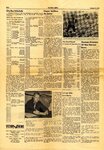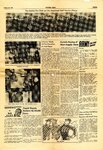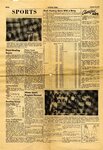| Title |
142_Victory News 20 October 1945 |
| Creator |
Defense Depot Ogden |
| Description |
The Victory News was the weekly newsletter produced by the Defense Depot Ogden during World War II. It included information on all the different operational departments at the depot, various recreational activities, and occasionally information about the Prisoner of War camp housed at the Depot. The Victory News for the week of March 5, 1943. |
| Subject |
World War, 1939-1945; Military bases--Utah--Defense Depot Ogden; Journalism, Military |
| Digital Publisher |
Stewart Library, Weber State University, Ogden, Utah, USA |
| Date Original |
1943 |
| Date |
1943 |
| Date Digital |
2008 |
| Type |
Text; Image/StillImage |
| Conversion Specifications |
Archived TIFF images were scanned at 400 dpi with an Epson Expression 10000XL scanner. JPG and PDF files were then created for general use. |
| Language |
eng |
| Relation |
https://archivesspace.weber.edu/repositories/3/resources/134 |
| Rights |
Materials may be used for non-profit and educational purposes; please credit Special Collections Department, Stewart Library, Weber State University. |
| Source |
MS 29 Box 31 Fd 1 Weber State University Special Collections |
| Format |
application/pdf |
| ARK |
ark:/87278/s6crnmg1 |
| Setname |
wsu_wwii |
| ID |
99020 |
| Reference URL |
https://digital.weber.edu/ark:/87278/s6crnmg1 |
| Title |
003_page3 |
| Creator |
Defense Depot Ogden |
| Description |
The Victory News was the weekly newsletter produced by the Defense Depot Ogden during World War II. It included information on all the different operational departments at the depot, various recreational activities, and occasionally information about the Prisoner of War camp housed at the Depot. The Victory News for the week of March 5, 1943. |
| Subject |
World War, 1939-1945; Military bases--Utah--Defense Depot Ogden; Journalism, Military |
| Digital Publisher |
Stewart Library, Weber State University, Ogden, Utah, USA |
| Date Original |
1943 |
| Date |
1943 |
| Date Digital |
2008 |
| Type |
Text; Image/StillImage |
| Conversion Specifications |
Archived TIFF images were scanned at 400 dpi with an Epson Expression 10000XL scanner. JPG and PDF files were then created for general use. |
| Language |
eng |
| Relation |
https://archivesspace.weber.edu/repositories/3/resources/134 |
| Rights |
Materials may be used for non-profit and educational purposes; please credit Special Collections Department, Stewart Library, Weber State University. |
| Source |
MS 29 Box 31 Fd 1 Weber State University Special Collections |
| Format |
application/pdf |
| Setname |
wsu_wwii |
| ID |
99442 |
| Reference URL |
https://digital.weber.edu/ark:/87278/s6crnmg1/99442 |







